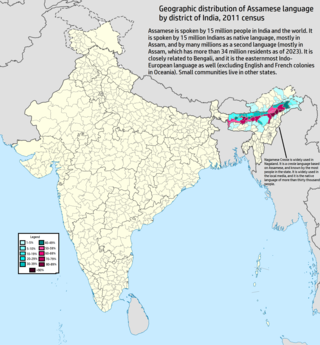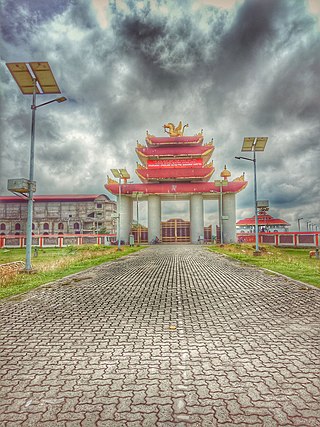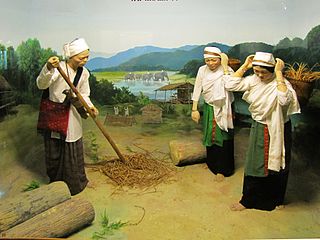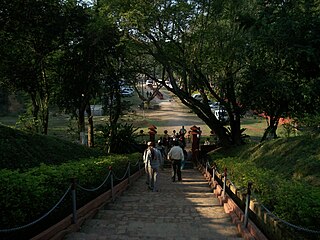
Thai, or Central Thai, is a Tai language of the Kra–Dai language family spoken by the Central Thai, Mon people in Central Thailand and the vast majority of Thai Chinese enclaves throughout the country. It is the sole official language of Thailand.

The Brahmic scripts, also known as Indic scripts, are a family of abugida writing systems. They are used throughout the Indian subcontinent, Southeast Asia and parts of East Asia. They are descended from the Brahmi script of ancient India and are used by various languages in several language families in South, East and Southeast Asia: Indo-Aryan, Dravidian, Tibeto-Burman, Mongolic, Austroasiatic, Austronesian, and Tai. They were also the source of the dictionary order (gojūon) of Japanese kana.

Assamese or Asamiya is an Indo-Aryan language spoken mainly in the north-eastern Indian state of Assam, where it is an official language. It serves as a lingua franca of the wider region and has over 15 million native speakers according to Ethnologue.

The Ahom script or Tai Ahom Script is an abugida that is used to write the Ahom language, a dormant Tai language undergoing revival spoken by the Ahom people till the late 18th-century, who established the Ahom kingdom and ruled the eastern part of the Brahmaputra valley between the 13th and the 18th centuries. The old Ahom language today survives in the numerous manuscripts written in this script currently in institutional and private possession.

The Ahom or Tai-Ahom is an ethnic group from the Indian states of Assam and Arunachal Pradesh. The members of this group are admixed descendants of the Tai people who reached the Brahmaputra valley of Assam in 1228 and the local indigenous people who joined them over the course of history. Sukaphaa, the leader of the Tai group and his 9,000 followers established the Ahom kingdom, which controlled much of the Brahmaputra Valley in modern Assam until 1826.

The Assamese alphabet is a writing system of the Assamese language and is a part of the Bengali-Assamese script. This script was also used in Assam and nearby regions for Sanskrit as well as other languages such as Bodo, Khasi, Mising, Jaintia etc. It evolved from Kamarupi script. The current form of the script has seen continuous development from the 5th-century Umachal/Nagajari-Khanikargaon rock inscriptions written in an eastern variety of the Gupta script, adopting significant traits from the Siddhaṃ script in the 7th century. By the 17th century three styles of Assamese alphabets could be identified that converged to the standard script following typesetting required for printing. The present standard is identical to the Bengali alphabet except for two letters, ৰ (ro) and ৱ (vo); and the letter ক্ষ (khya) has evolved into an individual consonant by itself with its own phonetic quality whereas in the Bengali alphabet it is a conjunct of two letters.

Boro, also rendered Bodo, is a Sino-Tibetan language spoken primarily by the Boros of Northeast India and the neighboring nations of Nepal and Bangladesh. It is an official language of the Indian state of Assam, predominantly spoken in the Bodoland Territorial Region. It is also one of the twenty-two languages listed in the Eighth Schedule of the Constitution of India. Since 1975 the language has been written using the Devanagari script. It was formerly written using Latin and Eastern-Nagari scripts. Some scholars have suggested that the language used to have its own now lost script known as Deodhai.
The Tai Le script, or Dehong Dai script, is a Brahmic script used to write the Tai Nüa language spoken by the Tai Nua people of south-central Yunnan, China. It is written in horizontal lines from left to right, with spaces only between clauses and sentences.

The Khamti language is a Southwestern Tai language spoken in Myanmar and India by the Khamti people. It is closely related to, and sometimes considered a dialect of, Shan.

Charaideo or Che-Rai-Doi is a historic town situated in Charaideo district, Assam, India. Charaideo was established by the first Ahom king Chao Lung Siu-Ka-Pha in the year 1253 CE as the first capital of the Ahom kingdom. Even though the capital was shifted to different cities over the course of 600 years of Ahom rule, Charaideo remained the symbolic centre of Ahom power in Assam. It is now famous for its vast collection of maidams (tumuli) which are the burial mounds of the ruling Ahom kings and members of the Ahom royalty.

Hajong is an Indo-Aryan language with a possible Tibeto-Burman language substratum. It is spoken by approximately 80,000 ethnic Hajongs across the northeast of the Indian subcontinent, specifically in the states of Assam, Meghalaya, Arunachal Pradesh, and West Bengal in present-day India, and the divisions of Mymensingh and Sylhet in present-day Bangladesh. It is written in Bengali-Assamese script and Latin script. It has many Sanskrit loanwords. The Hajongs originally spoke a Tibeto-Burman language, but it later mixed with Assamese and Bengali.
Khamyang is a critically endangered Tai language of India, spoken by the Khamyang people. Approximately fifty people speak the language; all reside in the village of Powaimukh, located seven miles downstream of Margherita in the Tinsukia district. It is closely related to the other Tai languages in the Assam region: Aiton, Khamti, Phake, and Turung.

The Chutia Kingdom was a late medieval state that developed around Sadiya in present Assam and adjoining areas in Arunachal Pradesh. It extended over almost the entire region of present districts of Lakhimpur, Dhemaji, Tinsukia, and some parts of Dibrugarh in Assam, as well as the plains and foothills of Arunachal Pradesh. The kingdom fell around the year 1524 to the Ahom Kingdom after a series of conflicts and the capital area ruled by the Chutia rulers became the administrative domain of the office of Sadia Khowa Gohain of the Ahom kingdom.
Assamese is part of the easternmost group of the Indo-Aryan languages. History of Assamese literature can largely be classified into three periods, including: Early Assamese period, Middle Assamese period and, Modern Assamese.

The Southwestern Tai or Thailanguages are a branch of the Tai languages of Southeast Asia. Its languages include Central Thai (Siamese), Northern Thai (Lanna), Lao, Shan and others.
The Aiton language or Tai Aiton language is spoken in Assam, India, in the Dhonsiri Valley and the south bank of the Brahmaputra. It is currently classified as a threatened language, with fewer than 2,000 speakers worldwide. Its other names include Aitonia and Sham Doaniya.
The Phake language or Tai Phake language is a Tai language spoken in the Buri Dihing Valley of Assam, India. It is closely related to the other Southwestern Tai languages in Assam: Aiton, Khamti, Khamyang, and Turung.

Ahomisation was an assimilation process in the former Ahom kingdom of Assam by which the people from different ethnic groups in the region became a part of what is now considered as the Ahom population.
Dr. Lila Gogoi was a writer, educationist and historian. He was the H. O. D. of Assamese department, Dibrugarh University and Honorary Director, Department of Historical and Antiquarian Studies in Assam. He was also the President of Assam Sahitya Sabha in the session of 1994.

The Shan alphabet is a Brahmic abugida, used for writing the Shan language, which was derived from the Burmese alphabet. Due to its recent reforms, the Shan alphabet is more phonetic than other Burmese-derived alphabets.















